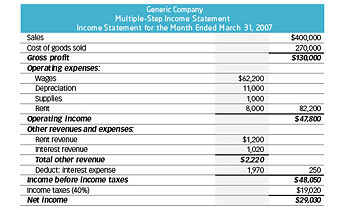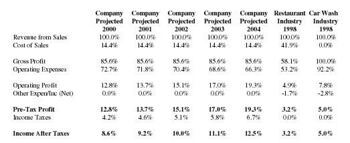Income statement
The income statement, also known as the "earnings statement" or "statement of operations", is one of the four financial statements used by accountants, business owners, and investors. The income statement provides a detailed look into how profitable a business has been over a designated period of time. It demonstrates how well the business has managed sales, expenses, interest paid, and taxes. If managed properly the income statement will show a net income. However, if the income statement shows a net loss it means the business was unable to operate profitably.
The income statement can be presented in two formats, the single-step and the multi-step. The single-step income statement adds the revenues and gains notated by the company, and the same is done for the expenses and losses. After this is completed the difference is taken between the two and the result will be the net income or loss for the company. The multi-step income statement displays the gross profit, which is the difference of sales and cost of goods sold; the operational income, which is the gross profit minus operating expenses minus depreciation; then the earnings before interest and taxes is calculated; and finally the interest paid and taxes are calculated into the income statement equaling the net income after taxes.
Creating an Income Statement
Single-Step Format
Revenues:
Revenue is the total amount of money a company actually receives during a specified time period
Net Sales
(also known as sales or revenue) The net sales in the income statement designates the amount of sales a company has generated after sales discounts, returns, and/or allowances have been deducted from the total sales of a specified time period.
Interest Income
The interest income is defined as the interest received by a company during a designated time period. The interest income received by the company can either be recorded as an earning or billed item to another company.
Gain on Sale of Assets
The gain on sale of assets is identified as the amount of money a company makes from sales of things such as equipment or investments during a specified time period.
Total Revenue
Total Revenue is calculated by adding net sales, interest income, and gain on sales of assets together. (Net Sales+Interest Income+Gain on Sales = Total Revenue)
Costs and Expenses
The costs and expenses include the costs of goods sold, operating expenses, interest expense, and income taxes that affect the total income earned by a company during a designated time period
Costs of Goods Sold
The costs of goods sold is calculated by adding cost of beginning inventory + costs of goods purchased + freight-in - cost of ending inventory. It is typically noted as the largest single expense on a financial statement.
Operating Expenses
The operating expenses are broken down into two different categories: Selling Expenses and General and Administrative Expenses. The selling expenses include sales salaries and commissions, payroll taxes related to the salaries, advertising, store supplies, depreciation of various items and products used for sales, and other various expenses. The General and Administrative Expenses include the salaries of those working for the company, payroll taxes related to the salaries, office supplies, depreciation of office supplies/buildings, rent, maintenance fees, business licenses, legal fees, accoutning fees, and other various expenses that keep the company running.
Interest Expense
The interest expense is a non-operating expense that defines the cost of money borrowed/used by a company during a specified time period.
Income Taxes
The income tax section is an account created by a company that shows what they intend to pay in taxes. However, it should be noted that the income tax amount has not actually been paid, it is simply a prediction of what the intended cost will be.
Total Costs and Expenses
The total costs and expenses is calculated by adding Costs of Goods Sold + Operating Expenses + Interest Expenses + Income Taxes
Net Income
(Revenues+Gains) - (Expenses+Losses) If the total revenue exceeds the total expenses this means the company was able to properly manage their daily operations and report positive earnings. However, if the company was unable to manage expenses properly then they would be reporting a net loss.
Multi-Step Format
Net Sales
Refer to Single-Step Income Statement
Cost of Goods Sold
Refer to Single-Step Income Statement
Gross Profit
Gross Profit=Net Sales - Costs of Goods Sold
Operating Expenses
Refer to Single-Step Income Statement
Operating Income
Operating Income=Gross Profit - Operating Expenses
Other Income and Expenses
Other Income includes:
- Interest Income-Refer to Single-Step Income Statement
- Gain on Sale of Equipment-The gain on sale of equipment is defined as the profit received from the sale of equipment. The company was able to sell the item for a higher price than what they previously purchased it for.
Other Expenses Include:
- Interest Expense-Refer to Single-Step Income Statement
Pretax Income
The pretax income is defined as the earnings received before income tax is calculated into the income statement.
Taxes
Refer to Single-Step Income Statement
Net Income
- Nets - Costs of Goods Sold = Gross Profit
- Gross Profit - Operating Expenses = Operating Income
- Operating Income + Other Income - Other Expenses = Pretax Income
- Pretax Income - Taxes = Net Income
GAAP and the Income Statement
The generally accepted accounting principles (GAAP), established by the Financial Accounting Standards Board, discusses how all public accounting information should be arranged and presented to the public. The GAAP does not go into specific details because these principles must be used by companies from numerous industries. All companies that are required to use GAAP must follow four basic principles: consistency, relevance, reliability, and comparability.
- Consistency: The company's financial information must be calculated and noted on the financial statements the same way each period. If the company changes how they present their information during a period they must note it in the financial statement and explain the reasoning for the change.
- Relevance: The information presented on the company's financial statements must be arranged in a manner that can be easily interpreted by any outside source. They must be able to get an idea of how the company will perform in future periods.
- Reliability: The information that the company presents on their financial statements must follow the standard guidelines because if they were to be audited then the auditor should get the same results as the company did. The company is presenting what really financially happened to them during a designated time period.
- Comparability: With companies using GAAP, outside sources can easily compare them financially because each company calculated their information following the same guidelines.
The guidelines that are established for creating an income statement should be the same for all companies in similar industries, in order to allow accurate calculations and comparisons to occur. This article discusses how single-step and multi-step income statements should be created and arranged.
The emergence of the income statement and managerial accounting occurred around the middle of the 19th century. During this time period banks were not only requiring balance statements from clients, but they also analyzed their profits and sales during a given time period. The first income statement consisted of sales and gross margin. The approach of the 20th century brought about the modern income statement that is used today.
Common Size Income Statement
The common size income statement differs from the typical income statement because it presents each section of the income statement as a percentage of sales. This type of income statement makes it easy for a company to analyze how each section will affect their profit and it also allows them to see how they are performing in comparison to their competition.
Relationship between Income Statement and Balance Sheet
The income statement and the balance sheet are linked by the net income of a company. The income statement reports the sources of revenue and expenses and the resulting profit or loss for a specified period. The balance sheet shows the company's assets, liabilities, and the difference between the two, which is known as shareholder's equity. The income that a company earns is recorded from the income statement and then reported under the shareholder's equity section of the balance sheet. The income statement and balance sheet show the total financial standing of a company through the income and shareholder's equity accounts.
Income Statement vs. Cash Flow Statement
The cash flow statement notes a company's inflows and outflows of cash during a given time period. It notes whether or not the revenues on the income statement have been paid or not. However, it does not necessarily list all of the expenses that a company has accrued over a given time period. This is because not all expenses have to be paid right away; therefore they do not have to be recorded on the cash flow statement until they are actually paid. However, the income statement notes all expenses even before they are paid.
Works Cited
Bradford, Tiffany. "GAAP and Accounting Standards." Suite101.Com. 6 Aug. 2007. 20 Apr. 2008 <http://gaap-standard-accounting-practices.suite101.com/article.cfm/what_is_gaap>.
Guvemli, Prof. Dr. Oktay. "The History of Vertical Income Statement." MUFAD. Marmara University. Apr. 2008 <http://www.mufad.org/index.php?option=com_content&task=view&id=168&lang=en>.
"Income Statement." Accounting Coach. 2008. Feb. 2008 <http://www.accountingcoach.com/online-accounting-course/04Xpg01.html#income-statement-introduction>.
Investopedia. "The Essentials of Cash Flows." Investopedia. 21 Apr. 2008 <http://www.investopedia.com/articles/01/110701.asp>.
Kennon, Joshua. "Income Statement Analysis." About.Com. Feb. 2008 <http://beginnersinvest.about.com/cs/investinglessons/l/blintroduction.htm>.
"Linking the Income Statement and Balance Sheet." MoneyInstructor.Com. 2006. 20 Apr. 2008 <http://www.moneyinstructor.com/lesson/linkincomebal.asp>.
"Understanding the Income Statement." Investopedia. Feb. 2008 <http://www.investopedia.com/articles/04/022504.asp>.


